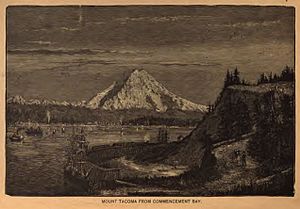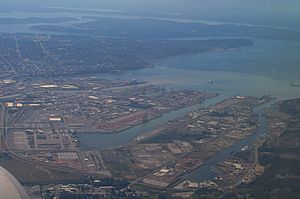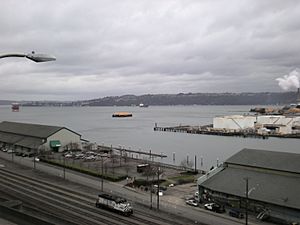Commencement Bay facts for kids
Commencement Bay is a large bay that is part of Puget Sound in the state of Washington, USA. Think of it like a big arm of the sea reaching inland. The city of Tacoma is built right on the bay, and its busy Port of Tacoma is located at the southeastern end. This port is one of the busiest commercial ports in the world!
The bay is generally considered to start where a line is drawn from Point Defiance Park in the southwest to Browns Point in the northeast. Many rivers and creeks flow into Commencement Bay. The Puyallup River is the largest freshwater stream that empties into the bay. Other smaller streams include Ruston Creek, Mason Creek, Asarco Creek, Puget Creek, Hylebos Creek, and Wapato Creek.
Contents
Exploring Commencement Bay's Past

How the Bay Got Its Name
In 1841, Lieutenant Charles Wilkes was exploring the area for the United States Exploring Expedition. He named this bay "Commencement Bay." He chose this name because it was the place where he began his detailed survey of the southern part of Puget Sound.
Early Settlers and Sawmills
The first European-American person to live on Commencement Bay was Nicolas Delin, a Swede. In 1852, he built a sawmill that used water power. It was located where a creek flowed into the head of the bay. A small community started to grow around his sawmill. However, the settlers had to leave during the Puget Sound War in 1855–56 and did not return.
The Railroad Arrives
A very important event happened in 1873. The Northern Pacific Railway, which was the first transcontinental railroad in the northern United States, announced big news. They said their main train station and shipping hub would be at Commencement Bay. When the railroad finally reached the bay in 1883, it caused a huge boom in development for Tacoma.
The railroad built its facilities near the wide, flat areas by the mouth of the Puyallup River. These areas were called "tide flats." They were perfect because they were flat, unlike the steep hills around the rest of the bay. Also, it was easy to dig out the area to make deep water access for ships. This allowed trains and ships to connect easily.
A new town, called New Tacoma, quickly grew up around the railroad hub. Soon after, the "Old Town" of Tacoma and New Tacoma joined together. The Northern Pacific Railway received large land grants, including a big part of the Commencement Bay coastline. Over time, the city of Tacoma bought much of this land back.
Changing Borders
Originally, the border between Pierce and King counties ran through Commencement Bay. This meant the bay was split between the two counties. But in 1901, the border was changed. This new border gave all of Commencement Bay to Pierce County.
Protecting Commencement Bay's Environment
For many years in the 20th century, a large metal smelting factory operated near Point Defiance. This factory was run by a company called ASARCO. The town of Ruston is located around where this old factory used to be. Waste materials from the factory were dumped into the bay, eventually forming a long piece of land sticking out into the water.
Today, this area is part of a special cleanup project called a Superfund site. A Superfund site is a place that has been polluted and needs a lot of work to be cleaned up.
The Thea Foss Waterway, which is an arm of Commencement Bay near downtown Tacoma, was also declared a Superfund site in 1983. However, there's good news! In 1991, the Environmental Protection Agency announced that the St. Paul Waterway, which was one of the most polluted parts of Commencement Bay, had been successfully cleaned. It was the first marine (ocean) Superfund site in the nation to be cleaned up!




